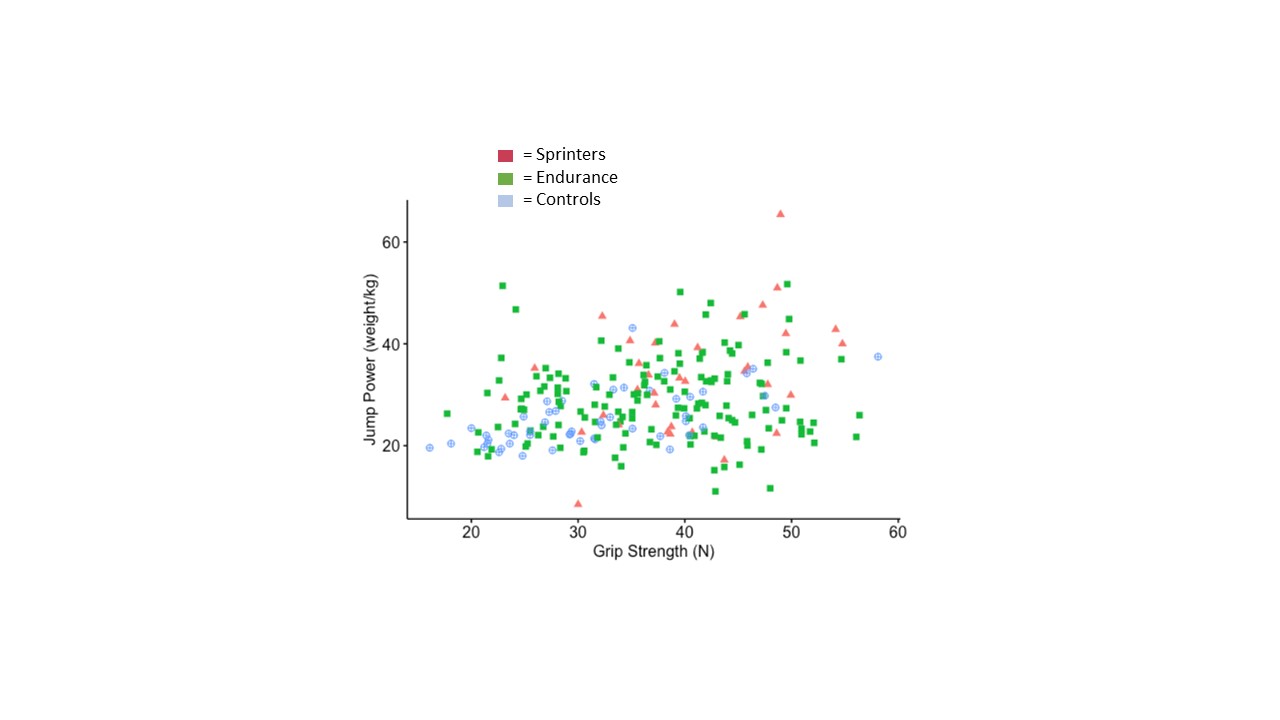Introduction Handgrip strength (HGS) is a widely used method to assess physical function in older adults and has been suggested as a biomarker of aging [1]. It is easy to perform and has been suggested to be a reliable indicator for vitality and several risk factors related to human ageing [2]. However, its utility in highly athletic older people is under-reported, particularly across different athletic disciplines. The purpose of this study was to determine the association between HGS and lower limb power in masters sprinters and endurance athletes, and healthy age-matched controls. Methods A total of 187 masters athletes consisting of 38 sprinters (71.1 ± 6.7 years; 28M 10F) and 149 endurance athletes (69.7 ± 5.5 years; 111M, 38F), and 58 age-matched controls (73.7 ± 5.1 years, 28M, 30F) were recruited from the UK. HGS was assessed using a handheld dynamometer (Jamar) and lower limb muscle power was measured using a Leonardo Jump Mechanography Platform during a countermovement vertical jump. One-way ANOVA analysis, adjusted for sex, was used to identify differences among groups. Mixed effects linear regression models, adjusted for sex, were performed to determine relationships. Significance was assumed when p<0.05. Results HGS in sprinters (40.28 ± 7.42 kg) was not statistically different to endurance runners (37.15 ± 8.87 kg) (p=0.106). However, both athletic groups had higher HGS than controls (31.89 ± 8.83 kg) (both p<0.05). Jump power in sprinters (33.3 ± 10.97 W/kg) was greater than in endurance athletes (28.8 ± 7.89 W/kg) and controls (25.18 ± 5.47 W/kg) (both p<0.05), with no significant difference between endurance athletes and controls (p=0.181). In regression models adjusted for sex, HGS was not associated with jump power in sprinters (β [95% CI]: 0.44 [-0.09 to 0.97], p=0.103) or endurance athletes (0.03 [-0.11 to 0.17], p=0.640). However, in controls there was a positive relationship between HGS and power (0.41 [0.2 to 0.63], p=0.000). Discussion and Conclusion These data demonstrate that HGS is a good predictor of lower limb function, as assessed by jump power, in non-athletic older adults only. These findings question the utility of HGS as a biomarker of physical function in masters athletes. However, given the known health-related benefits of life-long exercise [3], the clinical utility of this assessment tool to assess those most ‘at risk’ of functional deficits (and for example, falls and fractures) is supported by the relationship observed in our controls [4]. The reason for this dissociation in the utility of HGS as a biomarker of ageing must be explored further, so the correct tools to assess aspects of health-status can be used for individuals.
Future Physiology 2021 (Virutal) (2021) Proc Physiol Soc 47, PC34
Poster Communications: Exploring the utility of handgrip strength as a tool to predict lower limb function in masters athletes.
Emma Bergin1
1 University College Dublin, Dublin, Ireland
View other abstracts by:
Where applicable, experiments conform with Society ethical requirements.

